
![]() See Bahasa Indonesia translation
See Bahasa Indonesia translation
101st Edition : April 2022
Key Points
- Foot & Mouth Disease officially confirmed near Surabaya 28th April 2022.
- Northern Australian feeder cattle prices have declined for the first time in 2 years providing Indonesian and Vietnamese importers with an opportunity to return to profitability

Foot and Mouth Disease confirmed in Java
The first case was found on the 12/14th of April in Gresik, just north of the city of Surabaya. See map below. The official notification was made on the 28th of April (see Beef Central) with advice that about 1,300 animals were confirmed to be infected across 22 sub-districts around Surabaya which is Indonesia’s second largest city located at the eastern end of Java. The Department of Agriculture suspects that the origin of the disease may have been from sheep and goats smuggled across the Malacca Strait from Malaysia to Sumatra and then trucked through to Surabaya although this is yet to be confirmed.
The most important feature from an Australian perspective is the close proximity of the infected area to Bali. See the map below of East Java with the red dots showing infected locations surrounding Surabaya. Low down on the extreme right of the map below is a very small light green strip just off the coast of Java. This is the main ferry crossing to Bali where lots of tourist from Java drive their cars to holiday in Bali. At the same time large numbers of Australian tourists are just rediscovering Bali holidays after the long pandemic break. This represents a greatly heightened risk of disease transmission to Australia than before FMD was discovered in Java.
While FMD is a big problem for Indonesia, Australia, one of the world’s largest beef and sheep meat exporters, has the most to lose if infection spreads to our national herds.
I will be following this story as closely as I can.
Map of East Java with Surabaya surrounded by infected locations. The western tip of the island of Bali is on the very far right of the map (in green).
Indonesia : Slaughter Steers AUD $5.38/kg live weight (Rp10,600 = $1AUD)
Slaughter steer prices have spiked for the traditional peak demand period of the end of the month of Ramadan (1 May) and the beginning of Lebaran on the 2nd of May. Prices were reported in a range of Rp55k to Rp60,000 so I have used Rp57,000 per kg live weight as my indicator rate for April. These are the highest prices I have recorded in the 8 years I have been publishing this report. Despite these high prices, importers reported that sales numbers were well down on previous years. This was to be expected considering the combination of weak purchasing power after a long and difficult pandemic followed by rampant food inflation. While the religious festival of Lebaran is just a single day, the family holiday to celebrate Lebaran usually lasts for about one week. Fresh beef prices have also risen again during the month with the price of knuckle at the Pasar Modern wet market in west Jakarta at Rp170,000 per kg up from Rp160k last month. The price of frozen Indian Buffalo meat (IBM) has also risen to record levels with the rate at the end of April at Rp129,000 per kilo compared to Rp98,500 at the end of March.
It has been reported that the official government anti-corruption agency has been visiting importers to investigate their high prices. In the past all importers were convicted of cartel behaviour and punished with massive fines. These convictions were confirmed despite plenty of evidence to demonstrate that no such cartel activity could have taken place as the markets simply don’t work that way.
In support of their case importers are easily able to demonstrate the very high import prices of their product and the fact that they are struggling to break even on sales let alone making unreasonable profits. Just look at the graph above to see publicly available proof of how the price of Australian feeder cattle has been consistently rising to historic levels.
On the other hand, there are some questions that arise regarding the price of IBM. I am advised by a reliable source that the CIF price for IBM in February was in the order of USD$3.25 per kg landed Jakarta port. Using an exchange rate of Rp14,400 for $1USD this translates to Rp46,800 per kg. Assuming import costs for customs duties, taxes, financing, refrigeration, and logistics of say 30%, the cost for the product should be around Rp61,000 delivered to cold storage around Jakarta. Compare this figure to the current price in Jakarta supermarkets of Rp129,000 suggesting a total markup by traders and retailers of more than 100%. I would have thought that this price differential would be of much more interest to the anti-corruption watchdog than lot feeders making a loss on their sales of slaughter cattle.

Another unappetising offering of frozen Indian buffalo meat selling for Rp129,000 per kg in the Transmart Carrefour supermarket in BSD City, Tangerang, Jakarta.

Lots of activity in the last week of Ramadan at the Pasar Modern wet market in Tangerang.
Lumpy Skin Disease (LSD) has made some huge movements around Sumatra during April. See the map below presented by the Indonesian Department of Agriculture around the middle of April showing the alarming spread of the disease from the original infected location in Riau to 4 surrounding provinces including Aceh in the far north of the island. The distance from Riau to the top of Aceh is about to 900km. Perhaps the virus infected these northern areas of Sumatra by travelling in insects across the Malacca Straits rather than moving across the land from Riau. At this rate it should not be too long before LSD reaches the large imported Australian cattle populations in the feedlots of Lampung in the very south of Sumatra. It is interesting to note that as of the first week of May there are no reports of infection in the small number of Australian cattle in the feedlots around Medan in north Sumatra. According to the map below these feedlots are literally surrounded by locations with reported cases of LSD. Hopefully we will learn more about the spread the virus in Australian cattle when the infection reaches Lampung where the largest concentration of Australian feeders are located. If the speed of spread towards the north is any guide, then the virus could easily be found in Lampung during May.

This is a photograph of a screen presentation from the Director General of Livestock and Animal Health in the Department of Agriculture.
As of the first week of May there are still only limited supplies of LSD vaccine with none as yet been made available to feedlots containing Australian cattle.
The Indonesian government recently banned the export of palm oil products in response to rapidly rising domestic prices and reduced supplies. Indonesia is the world’s largest producer and exporter of palm oil products. The government has a 20% Domestic Market Obligation (DMO) which appears to have been ignored by some palm oil traders who preferred to take advantage of the extremely high international vegetable oil prices following the war in Ukraine. It is expected that the ban will be lifted once domestic supplies are restored and the traders demonstrate that they are complying with the requirements of the DMO.
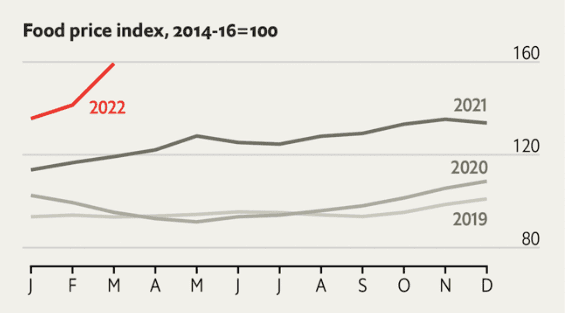
Graph showing world food price rises from the Economist.
Darwin feeder steer prices have finally fallen after a steady climb for the last 2 years. As noted in last month’s report, the rains failed to arrive in many parts of northern Australia by Easter (mid April) so producers across the north have commenced their accelerated sales of feeder cattle in order to reduce numbers and conserve what feed they have left for their breeding herds. The quote I have for Darwin feeder steers at the end of April was $4.80 a fall of 70 cents a kg from last month’s figure of $5.50. This will be welcome relief for importers who will be needing to stock up after their Ramadan and Lebaran sales. During April 8 cattle shipments left Darwin for Indonesia delivering 21,172 feeders. My advice is there are a similar number planned during May. If prices stay at the current level or move even lower, then this number of shipments might easily increase.
Drought conditions in the USA continue to deteriorate which will further reduce global grain supplies at a time when Russian and Ukrainian production is no longer available. Cattle production will also be impacted.
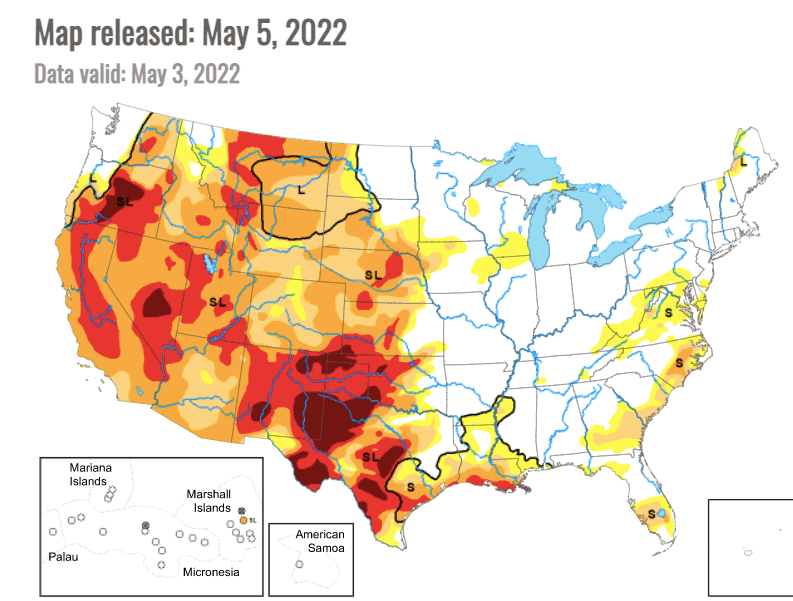
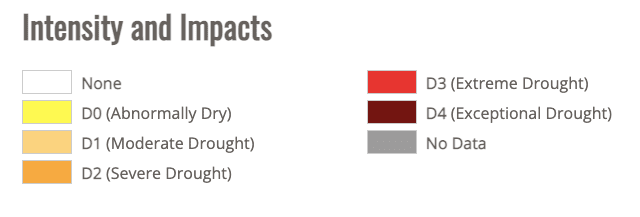
Vietnam : Slaughter Steers AUD $4.97 / kg (VND16,900 to $1AUD)
No change in slaughter cattle prices again this month with the indicator rate still at D84,000 per kg live weight for steers and D86,000 for bulls. The easing of northern Australian prices towards the end of April were enough to allow a number of shipments to sail to Vietnam including one from Darwin and I believe 3 from Townsville. This increase in trade has been made possible by the drop in slaughter cattle prices in both Darwin and Townsville and by ensuring the majority of animals in the shipments are bulls. Townsville rates have fallen to around AUD$4.00 per kg live weight which appears to be just enough for importers to at least break or even make a small profit. My Thai agent tells me that the Myanmar border is open again for exports of fat cattle which are not required in Thailand so the majority of these animals are going direct to Vietnam. With the Chinese border still closed, fat cattle are also being exported from Laos and Cambodia into Vietnam to fill the gap left after the dramatic reduction in Australian imports.
I have been advised by a number of sources that one of the larger lot feeders is preparing to import two back to back shipments of Brazilian slaughter cattle. Brazilian cattle are relatively cheap at the moment and the larger ships are not too busy so if a protocol can be agreed that doesn’t require an extended period of quarantine after arrival then this may well turn out to be a profitable venture. Tight margins will require the use of the largest ship available so it is likely that each consignment will be in the order of 14,000 head.
The total Vietnamese feedlot capacity is around 100,000 head with current stocks in April falling to around 20%.
China : Slaughter Cattle AUD $7.50 / kg live weight (RMB 4.76 = 1AUD$)
Slaughter cattle prices rose slightly in both Beijing and Shanghai this month with the average slaughter steer rate at Y35.4 per kg live weight. Beef prices were generally steady while pork prices rose by about 22% in both locations.
My reporter in Shanghai is currently under strict Covid lockdown so the prices this month have been provided by a friend in a nearby city that it not so tightly restricted.
China’s national cattle herd is still estimated at about 100 million head including 14 million dairy cattle. Imports for 2022 are forecast to be 375,000 head sourced from New Zealand, Chile, Uruguay, Laos, and Australia with the majority being dairy cattle and about 25% beef breeders.
Philippines : Slaughter Cattle AUD $3.37 / kg (Peso 38.0 to AUD$1)
No change in slaughter rates this month with the indicator rate remaining at Peso128 per kg live weight. My reporter advises that despite the impact of rising global fuel prices on the Philippines that the economy appears to be managing reasonably well with prices of food and essentials relatively stable. Beef, chicken and pork prices are unchanged from last month, Petrol prices remain steady at about P62 to P64 per litre. The presidential election will take place on the 7th May.
Thailand : Slaughter Steers AUD $4.02 / kg (Baht 24.85 to $1AUD)
Slaughter and feeder cattle prices remain weak with the average still holding at THB100 per kg live weight. My agent reports that the market is extremely quiet as food inflation, including beef is dampening retail demand. It also happens to be the “low season” for Thai beef consumption. The border crossing with Myanmar is open again with the majority of cattle passing directly through Thailand for sale in Vietnam.
LSD has now been in Thailand for a little over 1 year. The general report is that following vaccination the disease has largely been brought under control with little ongoing problems except in areas where vaccination has been missed.
Pasar Badung is the largest Wet Market in Denpasar, Bali
I visited this market with David Heath and his family early on a Sunday morning in mid-April. This market is a new construction on the same site as the original one which burned down about 5 years ago. There are a large number of beef stalls stretching for about 150 metres. All the beef is from locally slaughtered Bali cattle. There is no Indian buffalo meat sold here and I don’t think there is any sold anywhere in Bali. Prices were moderate with knuckle @ Rp105, Fillet at Rp130 and ribs at Rp70 per kg. Bali cattle beef has good colour and presents very well as hot meat.
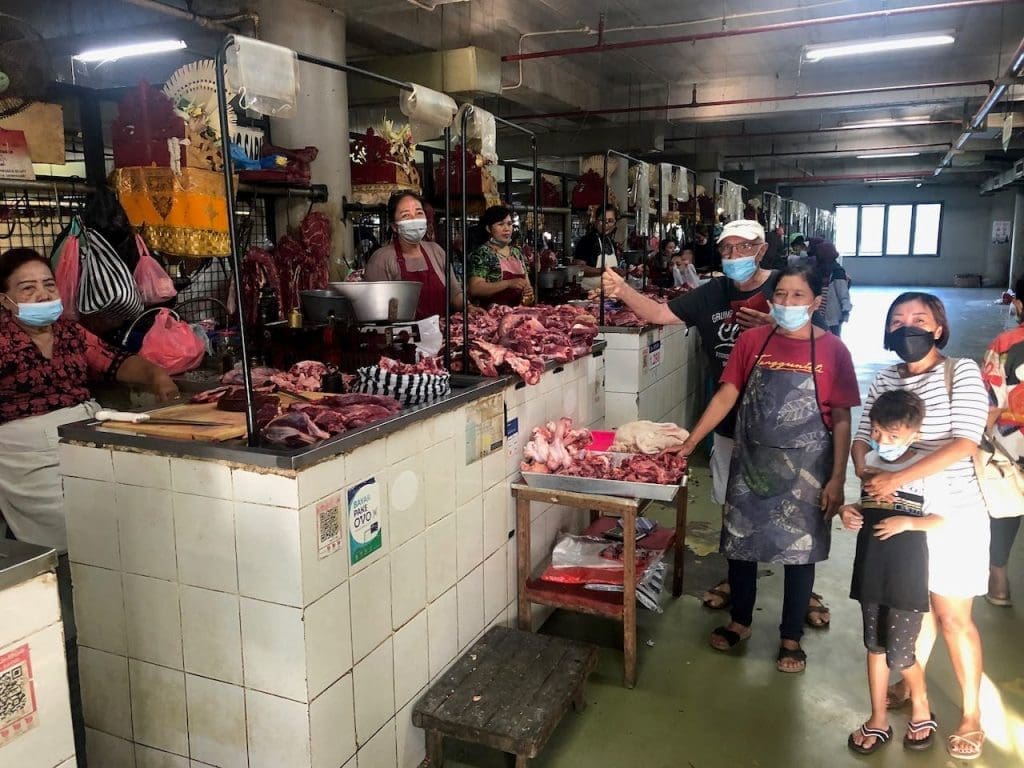

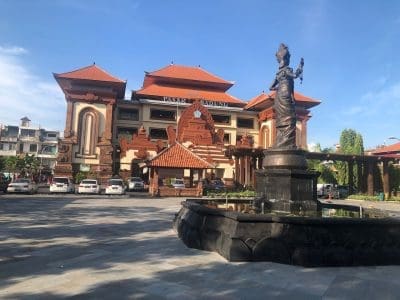
April prices
These figures are converted to AUD$ from their respective currencies which are changing every day so the actual prices here are corrupted slightly by constant foreign exchange fluctuations. The AUD$ figures presented below should be regarded as reliable trends rather than exact individual prices. Where possible the meat cut used for pricing in the wet and supermarket is Knuckle / Round.
| Location | Date | Wet Market
AUD$/kg |
Super market
$/kg |
Broiler chicken
$/kg |
Live Steer
Slaughter Wt AUD$/kg |
| Indonesia | Nov 21 | 14.42 | 15.19 | 3.85 | 4.80 |
| Rp10,200 | Dec 21 | 14.71 | 15.49 B13.04 | 4.21 | 4.80 |
| Rp10,200 | Jan 22 | 14.71 | 14.71 | 3.92 | 5.09 |
| Rp10,400 | Feb 22 | 14.42 | 14.33 | 3.65 | 5.05 |
| Rp10,500 | March 22 | 15.24 | 16.62 B9.38 | 3.62 | 5.05 |
| Rp10,600 | April 22 | 16.03 | 15.00 B12.17 | 4.25 | 5.38 |
| Philippines | Nov 21 | 14.36 | 15.18 | 3.52 | 3.66 |
| P36.2 | Dec 21 | 14.64 | 15.47 | 3.59 | 3.73 |
| P36.5 | Jan 22 | 14.52 | 15.34 | 4.66 | 3.50 |
| P37.6 | Feb 22 | 14.10 | 14.89 | 4.52 | 3.40 |
| P38.3 | March 22 | 14.10 | 14.88 | 4.31 | 3.34 |
| P38.0 | April 22 | 14.21 | 15.00 | 4.47 | 3.37 |
| Thailand | Nov 21 | NA | NA | NA | 4.51 |
| THB 24.0 | Dec 21 | NA | NA | 2.88 | 4.58 |
| THB 23.2 | Jan 22 | 11.59 | NA | 3.43 | 4.72 |
| THB 23.7 | Feb 22 | 11.39 | NA | 3.59 | 4.64 |
| THB 24.5 | March 22 | 11.02 | NA | 3.67 | 4.08 |
| THB 24.85 | April 22 | 11.67 | NA | 3.42 | 4.02 |
| Vietnam | Nov 21 | NA | 16.75 | NA | 4.94 |
| D16,300 | Dec 21 | NA | 16.75 | 4.91 | 5.03 |
| D16,200 | Jan 22 | 19.14 | 19.38 | 4.01 | 5.12 |
| D16,500 | Feb 22 | 18.79 | 16.18 | 7.09 | 5.09 |
| D16,800 | March 22 | 18.45 | 18.69 | 6.96 | 5.00 |
| D16,900 | April 22 | 18.34 | 18.58 | 6.92 | 4.97 |
| China Beijing | Nov 21 | 18.88 | 21.46 | 4.25 | 7.51 |
| Y4.46 | Dec 21 | 20.63 | 23.00 | 4.22 | 7.94 |
| Y4.54 | Jan 22 | 21.15 | 21.72 | 4.23 | 7.75 |
| Y4.60 | Feb 22 | 20.89 | 21.43 | 4.17 | 7.65 |
| Y4.68 | March 22 | 20.51 | 20.94 | 4.44 | 7.56 |
| Y4.76 | April 22 | 20.17 | 20.59 | 4.79 | 7.48 |
| Shanghai | Nov 21 | 20.60 | 25.32 | 4.29 | 7.55 |
| Pork per kg | Dec 21 | 22.11 | 27.35 | 4.04 | 8.03 |
| Beijing Y26.8 | Jan 22 | 21.71 | 26.43 | 4.01 | 7.84 |
| ShanghaiY28.8 | Feb 22 | 21.43 | 26.09 | 4.02 | 7.74 |
| March 22 | 21.06 | 25.64 | 3.97 | 7.56 | |
| April 22 | 21.43 | 25.63 | 3.91 | 7.52 | |
| Darwin Feeder Steer | Nov 19
$3.35 |
Dec 19
$3.25 |
January 2020
$3.25 |
Feb 2020 $3.80 | March 2020
$3.40 |
| April 20
$2.80 |
May 20
$3.25 |
June 2020
$3.40 |
July 2020
$3.50 |
August 2020
$3.40 |
|
| Sept 2020
$3.45 |
October 2020
$3.90 |
Nov 2020
$4.00 |
Dec 2020
$4.00 |
Jan 21
$4.10 |
|
| Feb 21
$4.30 |
March 21
$4.30 |
April 21
$4.20 |
May 21
$4.10 |
June 21
$4.10 |
|
| July 21
$4.05 |
August 21
$4.25 |
Sept 21
$4.20 |
Oct 21
$4.30 |
November 21
$4.50 |
|
| December 21
$4.70 |
January 22
$5.35 |
February 22
$5.45 |
March 22
$5.53 |
April 22
$4.80 |




One has to wonder whether our Australian authorities have sought the source of FMD in Indonesia?
From a marketing perspective this could close down some of our competitors from, say, India or South America, if determined and publicized.